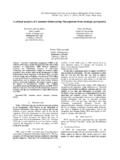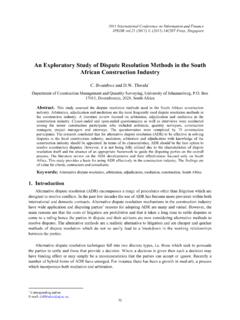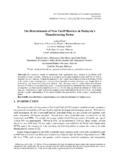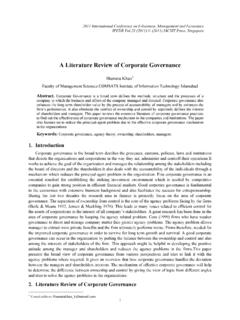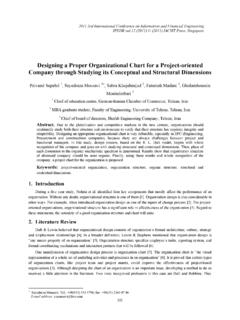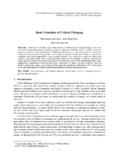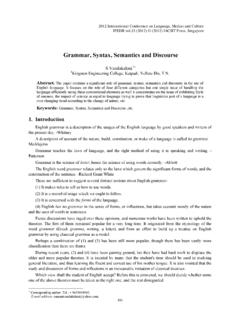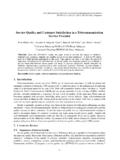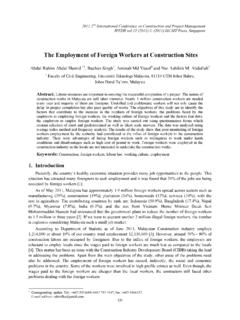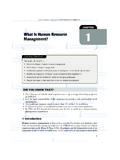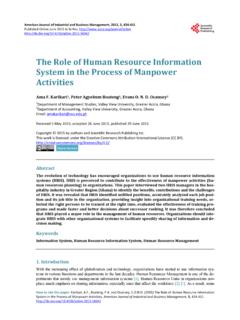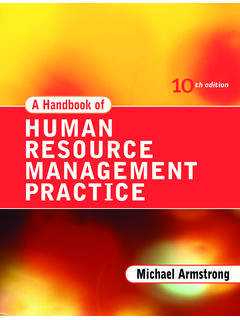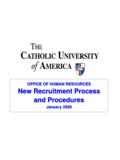Transcription of The Application of Talent Management at Human …
1 The Application of Talent Management at Human resource Management in Organization Petra Horv thov + V B Technical University of Ostrava, Faculty of Economics, Department of Management , Czech Republic Abstract. The paper is concerned with basic concepts, essence, content, significance, benefits of Talent Management and its processes - acquisition, development and retention of talents. It explains a key position of Human resources especially that of talented individuals for organization's successful working. Talents and their contribution to the organization it understands as one of the main competition edges. In the final part the article brings both information on the survey the role of which was to identify the level and quality of Talent Management used by organizations in the Czech Republic and it submits proposals for the wider Application of Talent Management approach in Czech practice. Keywords: Talent , Talent Management , acquisition, development, retention, usage 1.
2 Introduction In the current hard conditions of competition gaining a global character, in the conditions of growing pressures of business environment globalization, Human resources are becoming more and more key aspects for organizations. It is not financial means, modern and efficient techniques and technologies but people, efficient employees who appear to be the main competitive edge. Organizations that want to survive and grow, and overtake their existing competition and substantially increase their added value in growing competition, and to implement a competitive edge have to attract, cultivate and retain their talented employees, and, as long as possible, especially those who are extraordinary talented. However, this concerns a relatively small and ultimate group of the most talented potential employees and that is why a struggle of organizations for these employees is becoming considerably harsh.
3 Stock of the most capable people in the current population is rather limited. From that fact it clearly follows for organizations that in the interest of their competitiveness they have to fight for these limited sources and in the interest of their victory in this fight to find and employ the most efficient instruments. A follow-up care for talented employees, efforts aimed at their development and their retention in the organization should also go without saying. What are actually the essence, content, significance and benefits of Talent Management , what are its individual particular processes? 2. Specification of the basic concepts In principle, there are two basic views of what or who Talent is. Some people consider a talented individual as an extraordinary efficient employee with a high potential who can have a significant impact on organization's efficiency. They think that Talent Management concerns a key individual only competent people seeking higher or top positions [6].
4 Other experts, however, say that as a Talent can be practically considered anyone who is able to contribute to achieving organization's objectives and that Talent Management should not focus only on a small number of favored individuals. + Corresponding author. Tel.: + 420 59 6992442; fax: + 420 59 6110026. E-mail address: 50 2011 3rd International Conference on Information and Financial Engineering IPEDR (2011) (2011) IACSIT Press, Singapore One of the most common definitions describes a talented individual as a man who gives both a high performance and shows a high potential. Also the author of the article identifies herself with this definition of a Talent concept. As far as the definition of Talent Management is concerned, most experts share their opinions that, in short, the system in question is the system of acquisition, retention and development of talents.
5 Some authors, for example, consider as Talent Management the use of a mutually interconnected set of activities that are to ensure that the organization will attract, retain, motivate and develop abilities of talented people that it needs at present and will need in the future either [1]. The aim is to ensure a flow of talents and to realize that talents are the main resource of organization. BNET, a British server focused on the issues of Management defines Talent Management as acquisition, choice, identification, retaining, Management and development of employees about who are thought to have a potential for a high performance. The author of this paper considers a Talent Management as a set of organization's activities whose task is to acquire, develop, motivate and retain talented employees needed for the fulfillment of both current and future business objectives she thinks Talent Management . 3. Significance and benefits of Talent Management By means of Talent Management , by means of systematic work with talents the following situations and strategic issues, for example, can be solved - the issue of identification and needs of talents in connection with trading priorities; difficulties with filling the most important positions appear in the organization, there is lack of skilled people on the market; a process of acquiring employees in the organization is successful but it turns out to be difficult to retain talented employees there; it is not possible efficiently to find talents and to identify employees with a high potential; it is difficult to look for a balance between a retention of employees in their positions and providing opportunities for their further development in the organization; in the organization there is a high fluctuation, mainly in the most important segments of workforce.
6 'best practice' programs have been implemented in the field but any significant changes cannot be seen in the approach to the employees; organization's customers pass from the organization to competition thanks to earlier personal relationships with former employees; it is expected that in the future a considerable organizational growth will occur or the acquisition requiring a presence of experienced employees will be materialized; restructuring initiated by organization's needs will happen and etc. The main benefits resulting from a correctly set and applied system of Talent Management are as follows - talented employees contribute to a more considerable extent to the fulfillment of organization's strategy and economic goals; costs of fluctuation and acquirement of new employees drop; the organization becomes a sought after and attractive employer; talented employees are identified and retained; succession planning for key positions is more efficient as well as ensuring of employees from the internal sources and their motivation; talented employees are appointed to appropriate positions and their potential is better used; losses connected with vacant key positions are minimized.
7 4. Talent Management generally The efficient work with talents is based on building Talent Management strategy that will be in line with organization's philosophy and business strategy [4]. Only from that strategy and through the strategy of Human resources Management key decisions can originate suggesting whether and which activities of Talent Management should be implemented. Strategy of Talent Management is aimed at ensuring a fund of highly talented, competent, committed and loyal individuals able to contribute to achieving the current as well as future organization's requirements, a so-called Talent -pool. Three basic groups of processes leading to ensuring an adequate Talent pool is a practical outcome of Talent Management strategy. It is acquisition, development and retention of talents. Each of these processes includes in itself a whole number of related activities, a number of particular elements. Organizations differ in ways of how they manage their talents.
8 The ideal approach is to interlink all activities or at least most of 51them, which is what some organizations are really striving for [1]. Some firms, however, concentrate on one or two activities only, which is not the idea of a systematic approach to Talent Management . Talents acquisition The first step the organization has to take is to identify key roles. In connection with that the organization has to assess whether there are available employees with key competencies who will be needed in the future in dependency with business strategy [2]. As long as it has not sufficient existing resources then it has to find these talents. It may identify them among its present employees, from the internal resources or obtain them from the external resources, from labor market, by transferring of talents from competitive firms, from other branches, scouting of talents among employees who have got research fellowship in the organization, by scouting for talented individuals among students or graduates, by direct addressing the chosen individuals, by means of the Internet, specialized agencies and the like.
9 The identification of talents is made on the basis of assessment of their current performance and a forecast of their potential. Performance appraisal is the measurement of actually achieved results within those areas for which the specified individual is responsible, and/or competencies understood as critical for the success of performed work as well as of the entire organization. A forecast of potential is a prognosis for how many levels within the organization an employee can advance on the basis of their past/current performance appraisal, training and development, preferences in their careers and the current and planned levels of competencies. There are a number of methods the organization can use for performance appraisal and a forecast of employees' potential both from the internal and external sources methods serving to the identification of talents. For a certain type of employee it is always necessary to choose such kinds and combinations that would lead both to performance appraisal and a forecast of potential.
10 It is not possible to rely on one method only. It should also be born in mind that first it is necessary to know the criteria of identification and only then we can choose methods. Talents from own sources are usually sought for through a working system of regular appraisal within which a number of methods are utilized. To the most used methods belong the method of assessment according to set objectives (MBO - Management by Objectives), assessment centre, the analysis of critical events, and a 360 feedback. In order to identify talents from the external sources the tests of fitness, a method of assessment centre and behavioral (competent) talks can be used. After performance appraisal and a potential forecast, the very group of talented employees is specified - a Talent -pool is formed. Individuals meeting in advance determined criteria can be jointly indicated as talents or this group of talented individuals can be furthermore divided into three groups - top talents, talents and potential talents (see Fig.)
